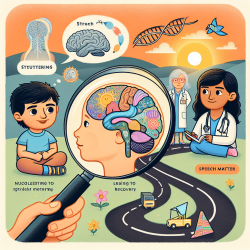Introduction
Stuttering is a neurodevelopmental disorder that affects 5-8% of preschool-aged children, with 1% of the population continuing to stutter into adulthood. Understanding the neural mechanisms that differentiate children who persist in stuttering from those who recover is crucial for improving therapeutic outcomes. A recent study titled "Brain developmental trajectories associated with childhood stuttering persistence and recovery" sheds light on this complex issue by examining the developmental trajectories of gray matter volume (GMV) and white matter volume (WMV) in children who stutter.
Key Findings
The study analyzed 470 MRI scans from 95 children who stutter (CWS) and 95 fluent peers, focusing on children aged 3 to 12 years. It identified significant differences in brain structure between children with persistent stuttering (pCWS) and those who recovered (rCWS).
- Preschool Age (3-5 years): pCWS exhibited reduced GMV in the putamen and nucleus accumbens and decreased WMV in white matter tracts, including the superior longitudinal fasciculus (SLF) and corpus callosum. These findings suggest early deficits in the basal ganglia-thalamocortical (BGTC) network.
- School Age (6-12 years): In older children, pCWS showed reduced GMV in the thalamus and decreased WMV in the internal capsule and SLF. This indicates that structural anomalies evolve as stuttering becomes chronic.
- Recovery Indicators: rCWS demonstrated increased growth rates in WMV, particularly in tracts connecting speech-motor structures, suggesting compensatory mechanisms that may facilitate recovery.
Implications for Practitioners
These findings have significant implications for speech-language pathologists and other practitioners working with children who stutter. Understanding the neural basis of stuttering can guide the development of targeted interventions that address specific brain regions and networks involved in speech production.
Practitioners are encouraged to consider the following strategies:
- Early Intervention: Focus on early intervention strategies that target the BGTC network, as early deficits in this area are linked to stuttering persistence.
- Neuroplasticity Support: Implement therapies that promote neuroplasticity, particularly in white matter tracts, to support recovery in children who stutter.
- Longitudinal Monitoring: Regularly monitor brain development in children who stutter to tailor interventions based on individual neurodevelopmental trajectories.
Encouragement for Further Research
The study underscores the importance of longitudinal research in understanding stuttering. Researchers are encouraged to build on these findings by exploring additional factors that may influence stuttering persistence and recovery, such as genetic predispositions, environmental influences, and cognitive development.
Conclusion
The study provides valuable insights into the neural underpinnings of stuttering persistence and recovery. By focusing on specific brain structures and developmental trajectories, practitioners can enhance therapeutic approaches and improve outcomes for children who stutter.
To read the original research paper, please follow this link: Brain developmental trajectories associated with childhood stuttering persistence and recovery.










